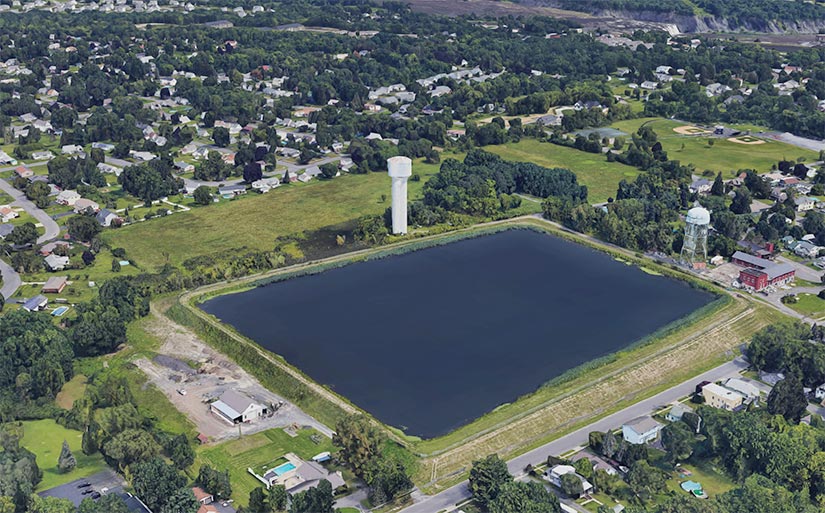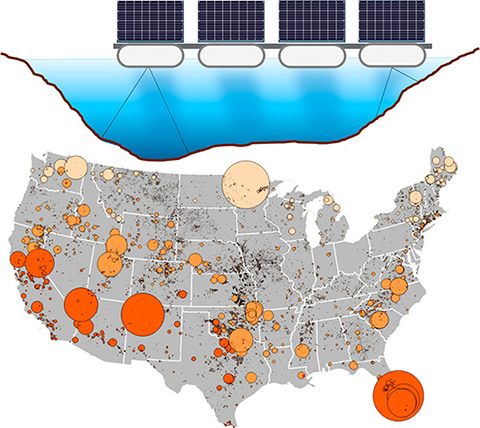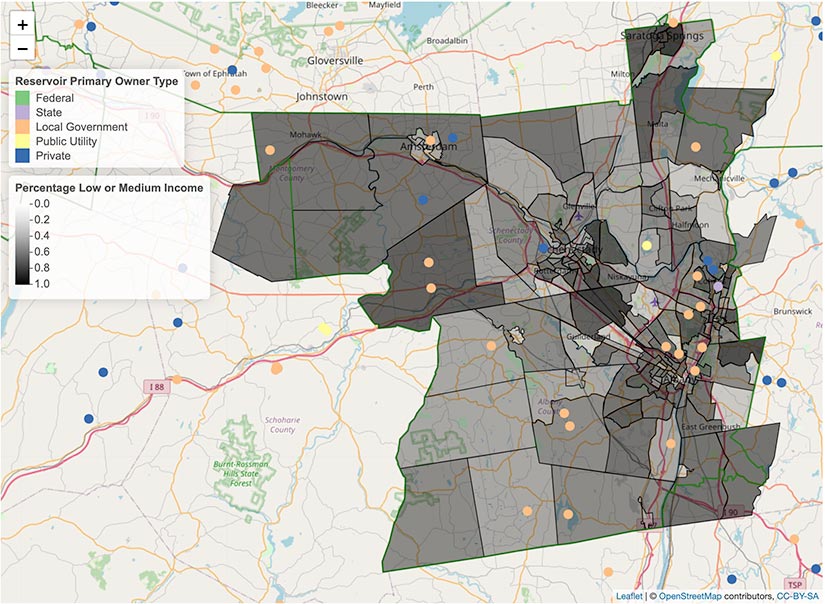Small City Sets Example for Floating Solar, Empowered by NREL Data Set
A First-Ever Approach to Municipally Owned Floating Solar Emerges in Upstate New York

Two city employees of Cohoes, New York, were brainstorming how to power the city’s municipal buildings with renewable energy, but few options made sense. Cohoes does not have acres of unused land for solar panels, and the slate-topped buildings cannot hold rooftop solar. Moreover, with its high amount of low- and moderate-income (LMI) residents, 17,000-person Cohoes was not swimming in cash. The solution had to be something local—something to keep cost savings within the community.
“We looked at every aspect of how to add clean energy to our working-class community,” said Theresa Bourgeois, director of operations for the city of Cohoes. “Then my colleague came upon the idea of floating solar. We considered our 10-acre water reservoir and asked, ‘Can we really utilize this?’ The more we researched, we realized yes, we can! In fact, it’s the best possible answer.”
No U.S. cities have done anything like what Cohoes was proposing: a municipally-owned and operated floating solar installation—but there was no reason it would not work. Bourgeois and City Planner Joe Seman-Graves did their research and learned that the technology of floating solar is sound and that their reservoir could hold enough panels to power all Cohoes city-owned buildings and streetlights—erasing around $500,000 in annual electricity costs—with 40% of the generated electricity remaining for civic use. Everything about the project lined up, but at a cost of $6 million, Cohoes needed buy-in from others.
Such clean energy investments are especially challenging for small and LMI cities because municipalities cannot access the same tax incentives as private companies when developing renewable energy. Instead, the city would need to make the case for state, federal, and foundation funding, and for that, they found their pitch in a 2018 National Renewable Energy Laboratory (NREL) report.
Discovery of NREL Study and Data Set Buoys Support for Floating Solar
The NREL report that Bourgeois discovered was “Floating Photovoltaic Systems: Assessing the Technical Potential of Photovoltaic Systems on Man-Made Water Bodies in the Continental United States.” The report provides coarse yet comprehensive data about potential U.S. “floatovoltaic” sites, including each reservoir’s estimated size, proximity to electric transmission, ownership status, and current use. For Bourgeois and Seman-Graves, NREL’s data set was the missing link.
“NREL’s study gave us confidence and credibility in the power of this idea, that we could generate clean energy in Cohoes,” Bourgeois said. “We used the basic results in that study to provide information to Congress, to our representatives, to the public, showing that we have a viable option. It really drove our success in building support for the project.”
The report portrays floatovoltaics as a large, unexplored opportunity for renewable energy. NREL found that if even a portion of the most suitable reservoirs were covered, floating solar could generate almost 10% of national electricity. That includes almost 25,000 human-made water bodies unused for recreation, mine tailings, and fish and wildlife.
In one instance, the report was invaluable when Cohoes first ran the idea by New York state agency officials. Bourgeois and Seman-Graves referenced the number of possible reservoirs that could support floating solar—492 in New York—to substantiate that not only are floatovoltaics viable, but that Cohoes could be at the forefront of a replicable model worth pursuing and funding. It was a strong enough case to win Cohoes some preliminary support.

Cohoes had similar success when running the idea by elected officials. NREL’s data identifies a value proposition for renewable energy that appealed to state and federal representatives alike, with the latter advocating to fund about 50% or more of project costs.
NREL also found that many of the suitable reservoirs are in water-stressed areas with expensive land and electricity—these areas could find a shortcut to solar power with floatovoltaics. But for Cohoes, one statistic was missing in the data: What about floating solar’s proximity to low-income communities? If the technology is such a practical option, how many other communities can use their own down-the-road reservoir for clean energy?
As the Cohoes Municipal Floating Solar Demonstration project becomes a model for municipal ownership and small-city sustainability, the city is using NREL’s data to share resources, educate, and advocate for environmental justice in related clean energy projects around the state, region, and country.
A New Life for NREL’s Data
While pitching the project, Bourgeois wondered whether NREL’s data could be even more impactful; a visualization that breaks the data into congressional districts and economic factors might sum all 7,000 words up in a few seconds to show the economic imperative for Cohoes. Bourgeois connected with NREL and learned that no such visuals were planned, but the authors would happily provide input; so, Bourgeois teamed with nearby Rensselaer Polytechnic Institute, sending NREL’s paper to Rensselaer’s Institute for Data Exploration and Applications (IDEA) where students and faculty engage with data of imminent societal importance.
The request was shared with John Erickson, director of research operations at IDEA, who is drawn to visualizing economic and technical data. He enthusiastically jumped in. His first goal was to visualize NREL’s data overlaid with LMI maps.
“Plotting the two data sets together was an eye-opener,” Erickson said. “Right away the possibilities for low-cost clean energy become clear.”
Erickson collaborated with Bourgeois and Seman-Graves to create the Floating Solar Explorer. The exploration tool is available online and includes a map of all the suitable reservoirs identified by NREL, as well as congressional district-scale LMI information layered over New York. Erickson originally bootstrapped the data explorer to share with Cohoes project stakeholders, but it is now shaping up to be a nice undergraduate elective.

“We try to have our students be driven by questions from elsewhere. NREL’s floating solar data set is an excellent launching point for students to use data to explore topics of deep importance,” Erickson said.
The exploration tool is a perfect example of the cross-community collaboration that Bourgeois and Seman-Graves envision and which is already accounted for. They plan for NREL’s data and accompanying visualization to be part of a wider virtual platform where the city can share and access information about the floating solar installation and where Cohoes can be a resource for K–12 education, university-based research, workforce development, and economic collaboration, all of which provide a roadmap for others to adopt community ownership.
“Supporting Cohoes in their ongoing effort to install floating solar has been a great example of one of the many ways NREL can support cities in deploying innovative renewable energy systems,” said Sika Gadzanku, who leads some of NREL’s floating solar projects and has led engagement with Cohoes over the last year.
“Creative solutions such as the Cohoes floating PV project are helpful for extending the benefits of solar to LMI communities,” said Jenny Heeter, lead author of NREL’s Affordable and Accessible Solar for All: Barriers, Solutions, and On-Site Adoption Potential report. LMI households can face barriers to installing rooftop PV such as difficulty financing a system, higher rental rates, and underinvestment in marketing and education to their communities. Likewise, communities are generally left out of tax incentives that are meant to spur renewable development. The newly updated DOE Solar Power in Your Community Guidebook offers resources for other communities wanting to install solar on government property and also includes discussion of both floating PV and engaging LMI communities.
Integrated Energy Pathways
This research aligns with one of NREL's critical objectives.
NREL also began cost benchmarking floating PV systems in 2021 to track their cost competitiveness nationwide. Another recent publication analyzed the benefits of pairing hydropower and floating PV systems around the world—a hybrid energy opportunity that could also be surprisingly cost friendly.
With Cohoes taking the charge toward clean energy justice, the success of NREL’s research in supporting the small-city energy transition is a case study in going from R&D to deployment.
Learn more about integrated pathways to energy transitions from NREL.

